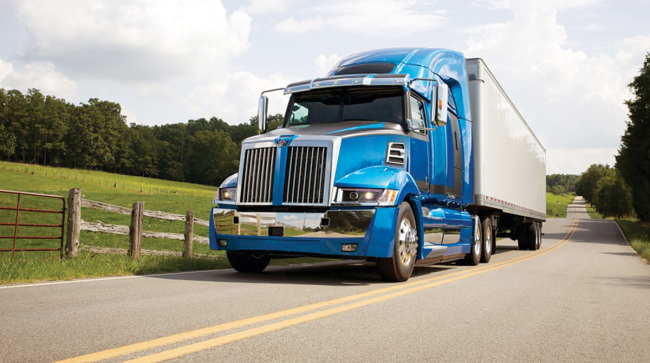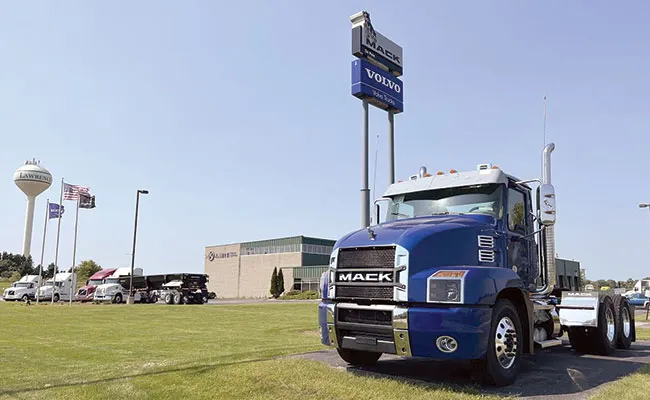Staff Reporter
Class 8 Truck Sales Down 6.7% in January

[Stay on top of transportation news: Get TTNews in your inbox.]
Class 8 retail sales kicked off the new year in January with a sixth consecutive month of year-over-year declines, Wards Intelligence data show.
Truck sales for the month decreased 6.7% to 18,594 compared with 19,932 during the year-ago period, according to Wards. Despite the overall drop, three of the seven major truck manufacturers posted gains for the month.
On a sequential basis, sales fell 20.5% from 23,390 units moved in December, a reversal from a nice year-end sequential jump from November to December that helped 2023 finish ahead of 2022. The January drop was a splash of cold water on that momentum, ACT Research Vice President Steve Tam said.
“We typically see a pretty meaningful increase in sales as the year closes out,” he said. “We did have a nice uptick, but not what we would normally expect to see, and then along comes January. Sales were down sequentially about 20%; usually they fall about 35%. If they didn’t go as high, I guess it makes sense that they didn’t fall as far.”

Tam
Tam observed during the recent round of fourth-quarter earnings calls that many carriers are cutting back on their capital expenditures. Sure enough, he has seen some equipment budgets decrease for the year and funds redirected into other ventures, such as real estate.
“It’s a cyclical industry, so that groundwork was already laid when we saw the slowdown in freight,” Tam said. “[Carriers] have a good sense of where their business is going this year. And for sure, [during] the first half, it’s not going to be as good as they might like. We have the opportunity to see things improve in the second half.”
Tam noted that equipment sales are influenced by freight volumes since carriers need less equipment when there are fewer shipments to move. He said he’s seeing some improvement in freight volumes and rates in the spot market and is hopeful these trends will translate into more permanent and resilient growth.
“We anticipated [sales] would come in somewhere closer to 22,000, but the drop-off is not abnormal,” FTR Transportation Intelligence Chairman Eric Starks said. “We did see the normal seasonal spike in December, so a one-month ease back is not unrealistic.”

Starks
He added, “The bigger concern for me right now is more about inventory levels and that we’ve started to see some elevation there. It’s not overly excessive, but it is starting to get to the point where it could start having some impact on the production side.
“We’re always saying that the [truck manufacturers] need to start cutting back on their production and their build. This will just add more fire to that with the easing of the sales.”
Freightliner, a brand of Daimler Truck North America, led sales for the month with 8,335 trucks sold. That represents a 44.8% market share. Fellow Daimler brand Western Star notched the largest year-over-year increase, with sales jumping 58.9% to 901 units from 567.
COMTO's April Rai offers tips to increase workforce diversity and grow profits.. Tune in above or by going to RoadSigns.ttnews.com.
Kenworth Truck Co. sales decreased 4.9% to 2,486 units from 2,614, while Peterbilt Motors Co. sales grew 9.6% to 2,694 from 2,459. Both are brands of Paccar Inc.
Mack Trucks’ sales fell 13.4% to 856 from 989, and Volvo Trucks North America’s increased 1.3% to 1,423 from 1,405. Both brands are owned by Sweden’s Volvo Trucks.
“Cooling of the heavy-duty tractor market is typical and expected in the cyclical market slowdown from the on-highway segment,” said Jonathan Randall, president of Mack Trucks North America. “That being said, deliveries are beginning to normalize, and demand for Mack Trucks remains strong.”
Navistar’s International brand saw sales fall 23.4% to 1,884 units from 2,459 last year.

A Mack truck for sale at Kriete Truck Centers' dealership in Green Bay, Wis. President David Kriete says a lot of volume-based vocational sales in the northern part of the country are on pause until the weather gets warmer. (Kriete Truck Centers)
“We definitely felt the effects of a slow January from a truck delivery standpoint,” said David Kriete, president of dealership Kriete Truck Centers. “Fortunately, the major reason for a lighter [year-over-year] is due to a strong year-end push from customers and manufacturers to sell and deliver on-ground product. Traditionally, it’s not uncommon to have a slow start to the year.”
Kriete added that a lot of volume-based vocational sales in the northern part of the country are on pause until the weather breaks, while other major sales packages aren’t executed until the fiscal year ends. Those factors are coupled with the earlier year-end push. As a result, he doesn’t view the 6.7% decline as a major cause for concern.

Clark
At least one industry analyst agrees.
“I don’t feel it’s surprising that Class 8 sales are starting to decelerate compared to last year’s supply-driven, pent-up demand that is now primarily satisfied, coupled with a still sluggish freight environment,” said Dan Clark, head of vehicle and equipment finance at BMO Commercial Bank. “As such, many larger fleets are now taking a step back to digest their recent capacity additions, while the smaller fleets are holding off for a better freight rate environment.”
Clark noted that these smaller fleets are risking the additional costs associated with maintaining older equipment. But he is optimistic that any retrenchment toward equipment replacement levels will eventually be a positive for freight rates, carrier profitability and equipment sales.
Want more news? Listen to today's daily briefing below or go here for more info:





